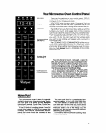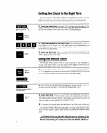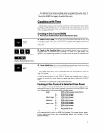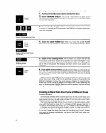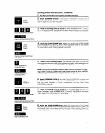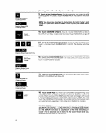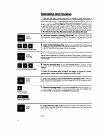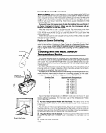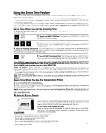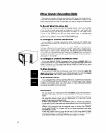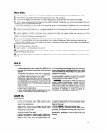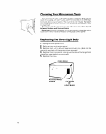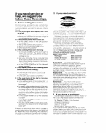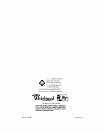
More Hints
1.
Most of the oven s weight IS on one side [the side with the controls)
and it may be awkward
to move
2. INDICATORS may flicker when the microwave oven IS on This
IS
normal
3. If your line voltage ts low (less than 120 volts], heating and cooking times may have to be longer.
4.
When using recipes other than those from the MICRO MENUS* Cookbook, you may have to experiment with
cooking limes and power level settings
Cook food accoralng lo the times and quantities given in the Whirlpool Cookbook. As in conventlonal
cooking. Over cooktng can burn food and some foods may flame Shorten cooking time for smaller quantities.
5. Popcorn should be made only In a popper designed for microwave use. Follow instructions received with
the popper The results are the responsibility of the popcorn popper manufacturer
6.
Llqulds heated tn certain containers may overheat and flash into vapor. Water can splash auf of the
container and make a loud noise This is not dangerous and will not harm the oven.‘You may wish to use a
different container for heating liquids next time
7. DO NOT OVERCOOK POTATOES At the end of the recommended cooklng time the potatoes should be
slightly firm Wrap potatoes In foil and set aside for five minutes. Potatoes will finish cooking while standing.
Some potato varieties may cook faster than others Overcooking may result In poor flavor and texture and
potatoes may scorch or flame
8.
Do not store utensils In the oven
9.
Use hot pads
some utensils can be hot
10.
Do not block the vents Normal exhaust from cooking is vented out the top and back Depending on the
food, the exhausl may be hot
11.
The Inner door liner may appear wavy after the microwave oven has been operated for a long time This IS
normal
l
After setting the oven, check the DISPLAY to
be sure the correct times and cook powers
are set.
l
Plug the microwave oven into a separate
15 ampere circuit. Use only an electrically
grounded three-pronged wall outlet.
l
Remove metal ties from plastic bags be-
fore placing them in the oven to avoid arcing
and possible oven damage. Check carryout
food containers for metal before reheating
foods in them.
l
Use your microwave oven only for cooklng,
reheating and defrosting.
l
Slice whole eggs before reheating to avoid
a steam build-up and possible bursting.
DON’TS
l
For cooking tlmes longer than four minutes,
avoid using paper containers [they may char)
and be careful of the plastics You use [some
plastics may melt).
l
Follow recipe instructions to stir, turn or add
foods between cooking cycles to avoid pos-
sible damage to the utensil or oven.
REMEMBER...If you call or write, provide your
name, address, telephone number, type of
appliance, brand, model, serial number,
date of purchase, the dealer’s name, and a
complete description of the problem. This in-
formation is needed in order to better re-
spond to your request for assistance.
0 Your microwave uses 1450 watts at full
power It can’t share an outlet with another
operating appliance.
l
Be careful that food or utensils do not push
against the plastic mode mixer cover Don’t
remove the cover shield.
l
Harsh abrasives may scratch the oven fin-
ish and shouldn’t be used.
l
Don’t use dishes or utensils with metal trim,
staples, closures or liners. Metals should be
used in the oven only as specifically di-
rected in the cookbook
* Always have food in the microwave oven
before operating it to avoid possible dam-
age to the oven.
l
Store nothlng in the microwave oven.
l
Scorched or burned foods are over-
cooked. Continued cooking can only burn
them further and may cause them to flame...
especially potatoes, corn-on-the-cob and
snacks
‘Tmk
17



